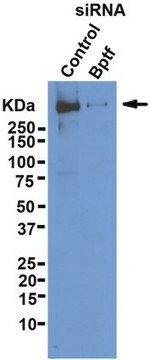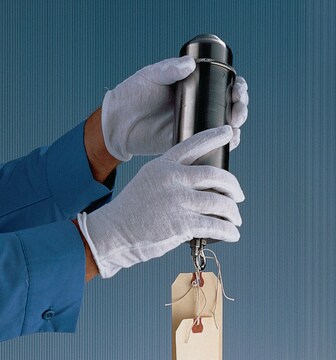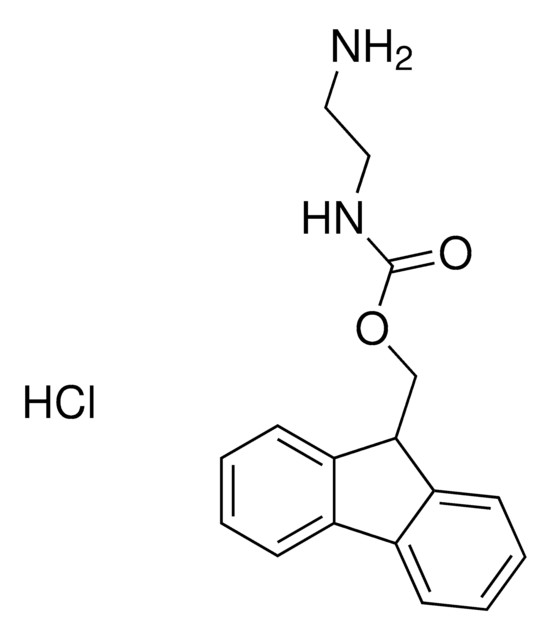ABE1966
Anti-BPTF (VCU19)
from rabbit, purified by affinity chromatography
Sinónimos:
Nucleosome-remodeling factor subunit BPTF, Bromodomain and PHD finger-containing transcription factor, Fetal Alz-50 clone 1 protein, Fetal Alzheimer antigen
About This Item
Productos recomendados
origen biológico
rabbit
Nivel de calidad
forma del anticuerpo
affinity isolated antibody
tipo de anticuerpo
primary antibodies
clon
polyclonal
purificado por
affinity chromatography
reactividad de especies
mouse
reactividad de especies (predicha por homología)
human (based on high sequence homology), rat (based on 100% sequence homology)
técnicas
ChIP: suitable (ChIP-seq)
western blot: suitable
Nº de acceso NCBI
Condiciones de envío
ambient
modificación del objetivo postraduccional
unmodified
Información sobre el gen
human ... BPTF(2186)
mouse ... Bptf(207165)
rat ... Bptf(303617)
Descripción general
Especificidad
Inmunógeno
Aplicación
ChIP-seq Analysis: A representative lot mapped BPTF chomsome 19 enrichment sites by ChIP-seq analysis (Courtesy of Joseph Landry, Ph.D, Virginia Commonwealth University School of Medicine).
Chromatin Immunoprecipitation (ChIP) Analysis: A representative lot detected BPTF occupancy at Ctcf-targeted chromatin sites containing BPTF-dependent nucleosome-free regions (NFRs) using mouse embryonic stem cell (mESC) chromatin preparation (Qiu, Z., et al. (2015). Mol. Cell. Biol. 35(1):224-237).
Western Blotting Analysis: A 1:1,250 dilution from a representative lot detected BPTF in 50 µg of wild-type, but not BPTF-knockout, mouse embryonic fibroblast (MEF) lysate (Courtesy of Joseph Landry, Ph.D, Virginia Commonwealth University School of Medicine).
Epigenetics & Nuclear Function
Calidad
Western Blotting Analysis: A 1:2,000 dilution of this antibody detected BPTF in 10 µg of NIH/3T3 cell lysate.
Descripción de destino
Forma física
Almacenamiento y estabilidad
Otras notas
Cláusula de descargo de responsabilidad
¿No encuentra el producto adecuado?
Pruebe nuestro Herramienta de selección de productos.
Código de clase de almacenamiento
12 - Non Combustible Liquids
Clase de riesgo para el agua (WGK)
WGK 1
Punto de inflamabilidad (°F)
Not applicable
Punto de inflamabilidad (°C)
Not applicable
Certificados de análisis (COA)
Busque Certificados de análisis (COA) introduciendo el número de lote del producto. Los números de lote se encuentran en la etiqueta del producto después de las palabras «Lot» o «Batch»
¿Ya tiene este producto?
Encuentre la documentación para los productos que ha comprado recientemente en la Biblioteca de documentos.
Nuestro equipo de científicos tiene experiencia en todas las áreas de investigación: Ciencias de la vida, Ciencia de los materiales, Síntesis química, Cromatografía, Analítica y muchas otras.
Póngase en contacto con el Servicio técnico
![3-[(2-Aminoethyl)amino]-1-propanol AldrichCPR](/deepweb/assets/sigmaaldrich/product/structures/193/734/c3b3e55a-2f61-43c5-8804-ff55209c4b55/640/c3b3e55a-2f61-43c5-8804-ff55209c4b55.png)







